What We Can Learn From Pitchers About Shoulder Health
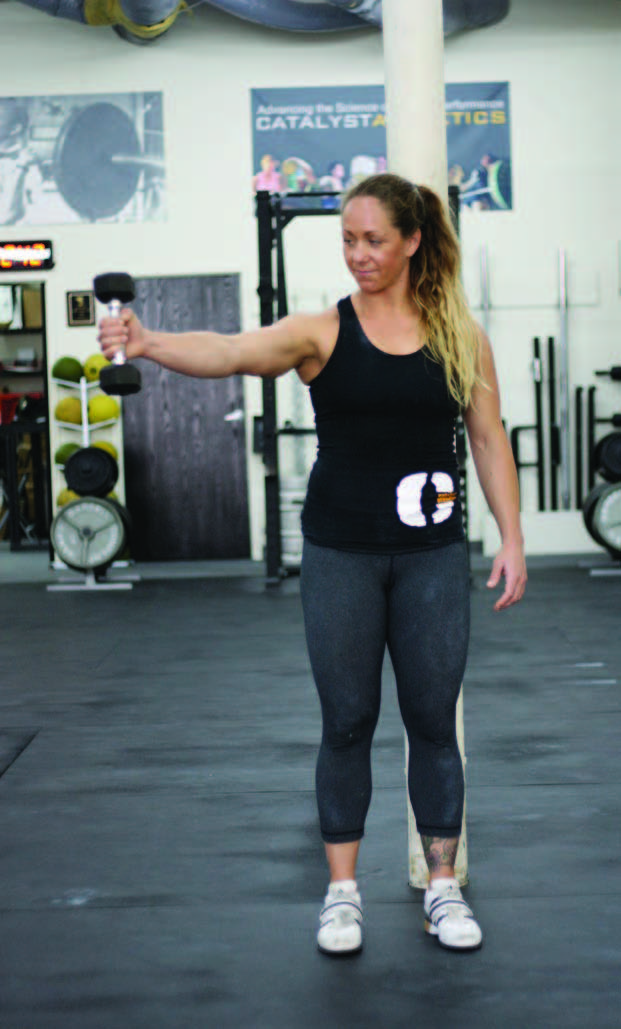
A professional pitcher’s arm can rotate up to 2500 degrees per second during a pitch, one of the fastest recorded human motions. To slow the arm down requires a force of approximately one half the pitcher’s body weight on some very small muscles. These motions put an incredible amount of stress on the shoulder. For this reason, no other motion or joint has been studied biomechanically as much as the pitcher’s shoulder. Whether you are hurling 95 mile per hour fastballs, doing clean and jerks, or just trying to get in better shape, this research can help you maintain shoulder health and enjoy your workouts more.
Shoulder Mechanics
The shoulder is one of the most flexible and mobile joints in the human body. Most joints have significant freedom in one plane and minor freedom in other planes. Consider the knee or elbow, which can flex and extend but have much more limitation in rotation. The reason the shoulder and hip have greater freedom of movement is their ball and socket design. The shoulder’s ball, known as the humeral head, is only 33% covered by the socket, or glenoid cavity, which is a part of the shoulder blade. This is the reason the shoulder has more range of motion than the hip. Due to the lack of bony structure supporting the shoulder joint, it requires significant muscular support to maintain stability.
The shoulder is actually four separate joints which work together to form what is called the shoulder complex, this also contributes to the freedom that the human shoulder exhibits. The ball and socket part of the shoulder complex is known as the glenohumeral joint. Above the glenohumeral joint is the acromioclavicular (AC) joint, which forms between the shoulder blade and the collarbone. The collarbone forms a joint with the sternum near the center of the chest. The shoulder blade forms a pseudojoint with the ribcage and this is the fourth part of the shoulder complex. Since the shoulder blade is a part of three of the four joints, the stability, mobility and strength of the muscles surrounding the shoulder blade are extremely important in shoulder health.
Although the muscular support system of the shoulder is vital in stabilization, there is a passive system of support as well. The labrum, which is a soft fibrous tissue, extends out from the glenoid cavity to help support the humeral head. This essentially deepens the glenoid cavity, which gives the ball a deeper socket to rest in. Several ligaments support the shoulder complex and help to support both the AC joint and glenohumeral (ball and socket) joint. One of the most important non-muscular supports is the joint capsule. This is also one of the most overlooked structures in shoulder health. The capsule is a fibrous structure that surrounds the entire joint. Although these passive structures are important in supporting the shoulder they often don’t play a role until the end range of a given motion. For example, if you lift your arm out to the side, the inferior shoulder ligaments don’t tighten until the arm is above your head, at which point they stop the motion. This fact is important in incidents like falls and fast, aggressive movements. In a fall on an outstretched hand, muscles contract to slow your body down as you hit the ground. If the muscles are not strong enough or do not react quickly enough to slow the body’s momentum before the shoulder reaches the end of its range of motion, the force is then transferred to the labrum, capsule, and ligaments which are then vulnerable to injury. In a fast, aggressive motion such as pitching, this occurs during deceleration after the ball is released. The muscles, mostly the posterior muscles, have to slow the arm down to prevent the shoulder from being pulled out of socket by the forward momentum. If the muscles are too slow or too weak the force is transferred to the labrum and capsule. This is also true of a motion such as the snatch. As the weight comes to a stop at the top of the motion the shoulders are essentially at end range. If the muscles cannot stop enough of the momentum, the force is again transferred to the passive structures.
Shoulder position has a large impact on the stabilizing structures. A good example of this is shoulder abduction. Try to lift your arm straight out to the side with your thumb pointed down (internally rotated). The shoulder will stop at approximately 120 degrees. Now try the same motion with the thumb pointed up. A healthy shoulder will now be able reach well above your head. The rotation that takes place at the top of your shoulder causes different forces on the stabilizing structures. With the thumb pointed down the anterior portion of the shoulder capsule twists, which causes it to tighten earlier in the motion.
The Problem
The great mobility the shoulder complex allows is also the reason it is prone to injury. Perfect shoulder motion involves the humeral head remaining perfectly centered in the glenoid cavity. If the humeral head moves out of the center of the glenoid as the arm is moved, then more pressure is placed on the structures and tissues responsible for shoulder stability. Shoulder instability is considered to be a precipitating factor in many shoulder conditions including impingement, tendinitis, rotator cuff tears and osteoarthritis. Movement of the humeral head is called translation. For example, when a pitcher’s arm begins to accelerate forward, a large posterior force is exerted on the end of the arm. This causes the humeral head to want to move forward or translate anteriorly (similar to a lever). Studies have shown that one of the most important muscles at this phase is the latissimus dorsi, which fires to prevent this from happening. In weightlifting, one of the most common ways to injure a shoulder is to do a deep bench press where the elbows are behind the torso. The weight is a large backward force on the end of the arm. This can cause the humeral head to translate, or shift, forward. If you have ever been told to balance bench presses with bent over rows or other back exercises, now you know the reason why.
One of the most well-known and important stabilizers of the shoulder is the rotator cuff. The cuff is actually comprised of four muscles that originate on the shoulder blade and insert into the humerus. The reason the cuff is so important is that its main function is to keep the humeral head centered in the glenoid cavity, as was earlier discussed. The cuff accomplishes this in two main ways, compression and depression. The supraspinatus, which is above the ball and socket joint, pulls or compresses the humeral head into the glenoid cavity. The other three muscles work to pull the humeral head down and prevent it from translating upwards. These two mechanisms put a large emphasis on muscle balance. The shoulder stays healthy by having muscles with forces that pull in opposite directions work together to rotate the arm without causing translation (or shifting), this is called a force couple. Again, the best example of this is lifting the arm up straight out the side. As the arm is lifted up most of the power to actually lift the arm is provided by the deltoid (around 89%). This force also pulls the humeral head upwards. The rotator cuff steps in to compress the humeral head into the glenoid cavity and depress, or hold down, the humeral head. An imbalance of this force couple causes the humeral head to translate superiorly. If you have ever seen someone doing flys and shrugging their shoulders dramatically, they are using their trapezius muscles to pull the structures above the ball and socket joint out the way as their humeral head translates upward.
Another important force couple exists between the muscles that surround the shoulder blade. Since the glenoid cavity is part of the shoulder blade, it must rotate to move the glenoid with the humerus. Also, the acromion, which is the “A” in AC joint and attached to the shoulder blade, is located above the humerus. If the shoulder blade rotates so the glenoid can follow the humerus upward, the acromion moves with the glenoid and is no longer in the way. The glenoid cavity can also move forward and backward to some extent which helps prevent anterior and posterior translation of the humeral head. This involves the shoulder blade moving forward along the ribcage. The force couples that surround the shoulder blade involve the upper trapezius, lower trapezius, rhomboids, and serratus anterior muscles. Due to their different directions of pull, these muscles rotate and spin the scapula to keep up with arm movement. Think of our earlier example of the pitcher’s arm accelerating forward. As the elbow experiences a strong force in the backward direction and the humeral head is pushed forward, the glenoid cavity moves forward slightly to keep up. To further complicate this issue, the humerus is forcefully and dramatically externally rotated. If you have ever seen a still picture of a pitcher in mid-throw, you know what I am talking about. As the humeral head spins, the glenoid must spin as well. If you want to feel this happen lift your right arm to shoulder height with your elbow at a 90-degree angle. Put your left hand on the lowest most lateral part of the right shoulder blade. Now externally rotate your right arm by moving your right hand backwards while keeping your right elbow where it is. You should feel the tip of the shoulder blade move forward. This motion is the shoulder blade rotating so the glenoid can keep up with the humerus. The coupling of motion between the different moving parts of the shoulder complex is put to the test by the speed involved in throwing a baseball. While lifting weights is not done as quickly as throwing, the shoulder is stressed by a different force, the weights.
Pre-hab
To protect the shoulder joint, it is important to approach it from two ways: strength and flexibility. A fine balance has to exist between strength and flexibility for the shoulder to work correctly. The strength portion of shoulder injury prevention can then be further broken up into the rotator cuff and shoulder blade muscles. All exercises and stretches should be performed on both sides.
Rotator Cuff
To strengthen the rotator cuff, it is best to use an elastic cord or 1-4 pound weight depending on strength level. The rotator cuff can be strengthened using three exercises: internal rotation, external rotation and abduction. Research has shown that working muscles in an eccentric fashion is beneficial for rehabilitation and injury prevention. An eccentric contraction occurs when a muscle is contracting but increasing in length. This happens as the posterior shoulder muscles slow a pitcher’s arm down, the quadriceps slow/stop a squatter’s drop down, or a pectoralis slows/stops the weight bar during a bench press. These exercises can all be performed every other day or 3 times per week, 3 sets of 8-12 reps.
Internal Rotation (with elastic)
Internal rotation strengthens the subscapularis muscle, which is located on the back surface of your armpit. This muscle is the primary internal rotator of the humerus and is important for depressing the humeral head and also preventing the humeral head from translating forward. To perform the exercise, attach a rubber cord to an object at waist height. Stand with the side you wish to exercise facing the cord and grasp the cord in that hand. Stand far enough away that there is a mild tension in the cord. Keeping your elbow pressed against your side, bring your arm to your stomach and slowly return to starting position. Try to bring the arm to your stomach for a count of one and back to the beginning at a count of three. Avoid using your hips/core to rotate and focus on slowly rotating the humerus.
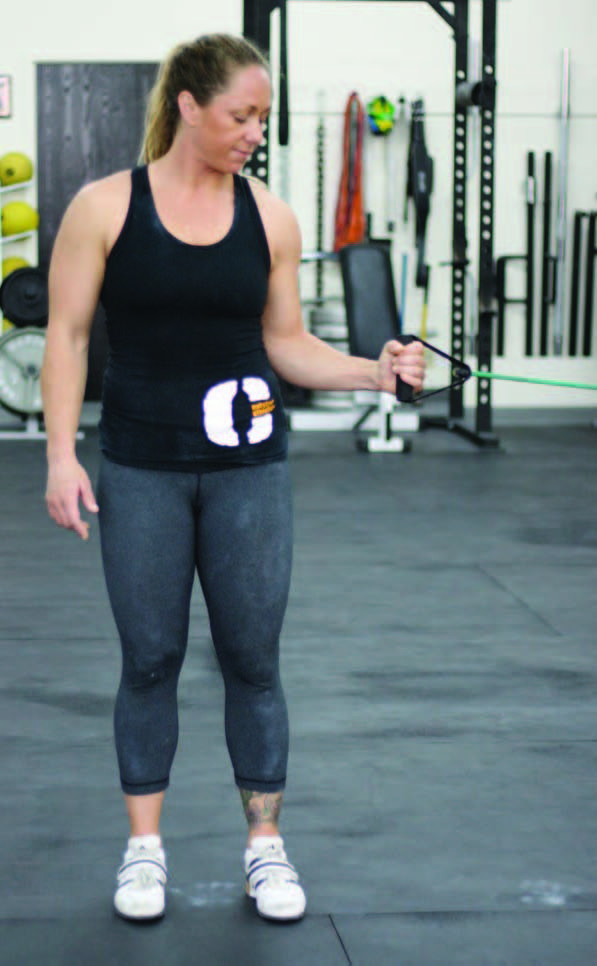
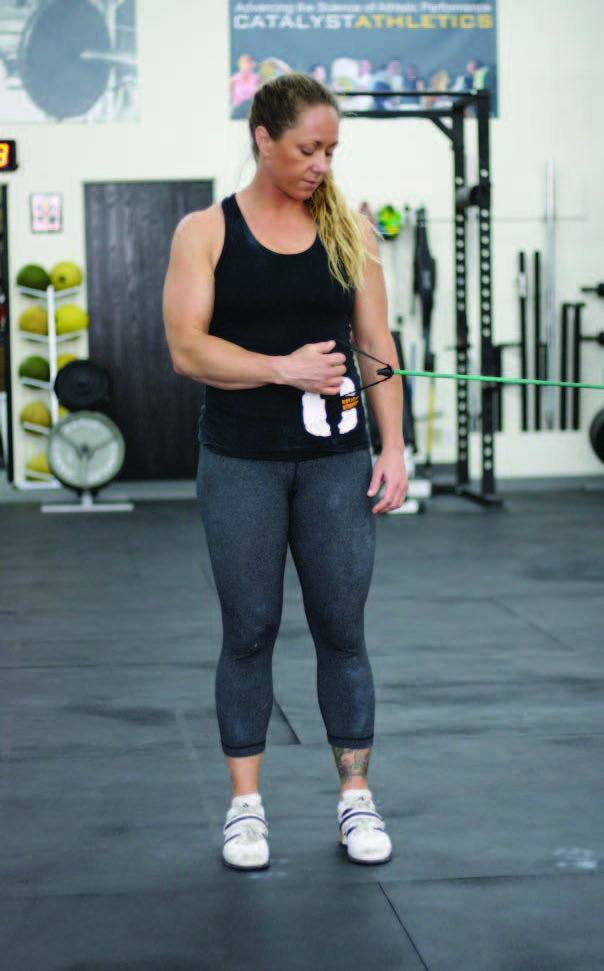
Internal Rotation (with weight)
Lie on the shoulder you want to exercise and roll slightly back so you are mostly laying on the shoulder blade. Start with a small weight in your hand resting on the floor. Bring the arm to your stomach. Focus on up for a count of one, down for a count of three.
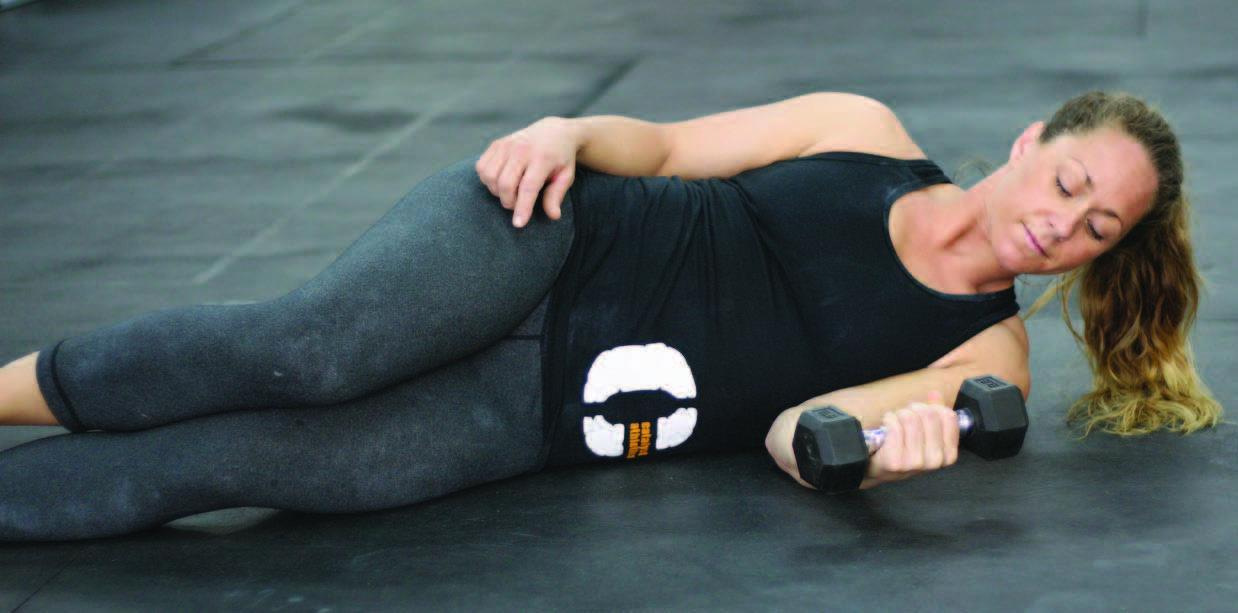
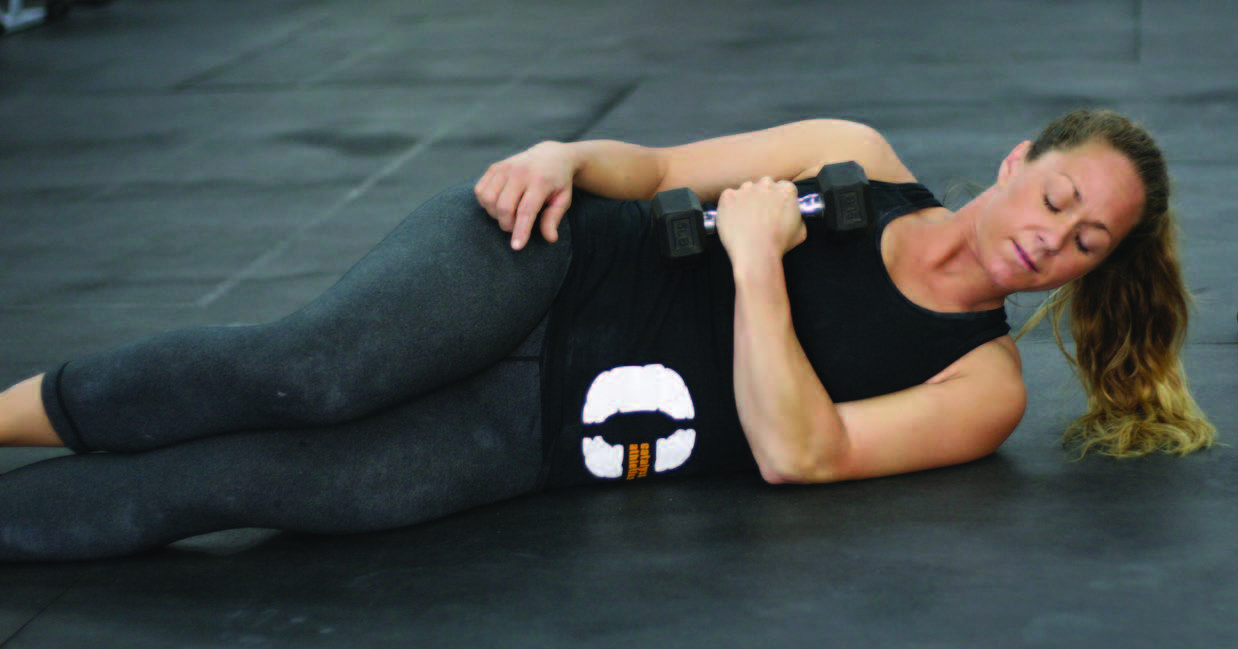
External rotation (with elastic)
Perform this exercise the same as internal rotation, except with the arm you wish to exercise facing away from the attachment point of the elastic. Begin with the forearm against your midsection and rotate outward, keeping your elbow pressed against your side. Focus on going out for one second and back in for three seconds. This exercise will strengthen the teres minor and infraspinatus (rotator cuff muscles) and will help prevent the humeral head from impinging on structures above it.
.jpg)
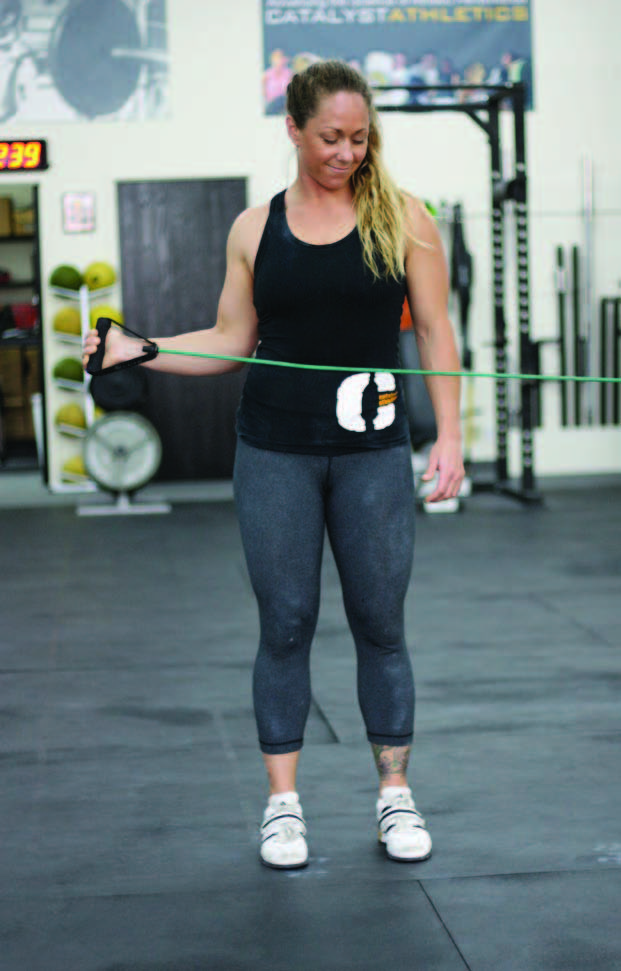
External rotation (with weight)
Perform exercise the same as internal rotation except lie on the non-exercise side. Again focus on going up for one second and down for three seconds.
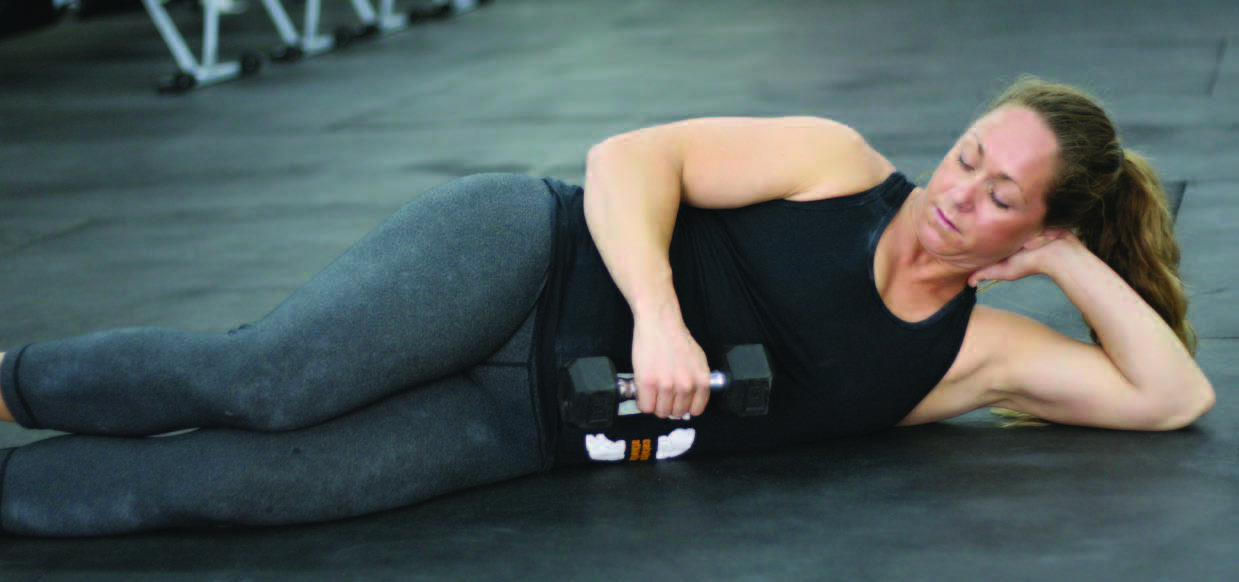
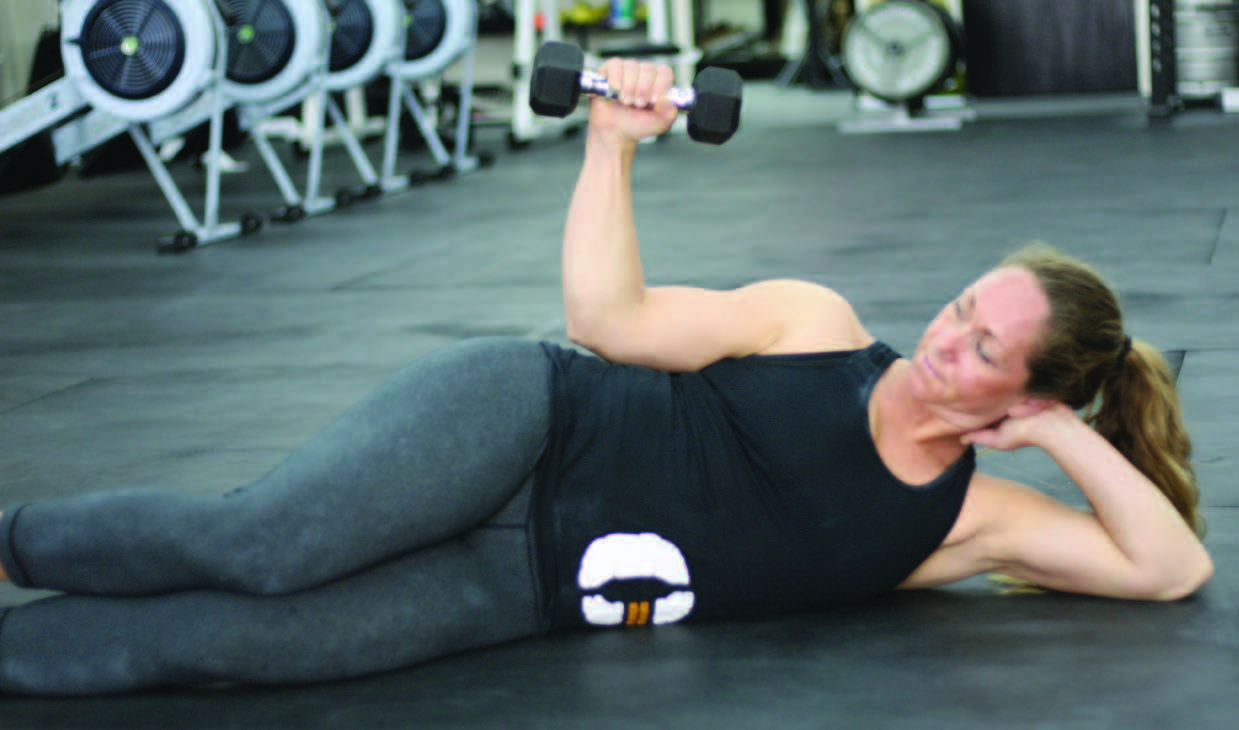
Abduction (with elastic)
Stand on an elastic band with your right foot to work the right shoulder and vice versa for the left. Start with arm at side and lift up with the arm straight. This exercise should be performed with the thumb pointing upward. To prevent aggravation of existing shoulder injuries, the arm should be lifted at an angle halfway between straight forward and straight to the side as this minimizes any impingement of the humeral head. Focus on going up for a count of one second, down for a count of three.
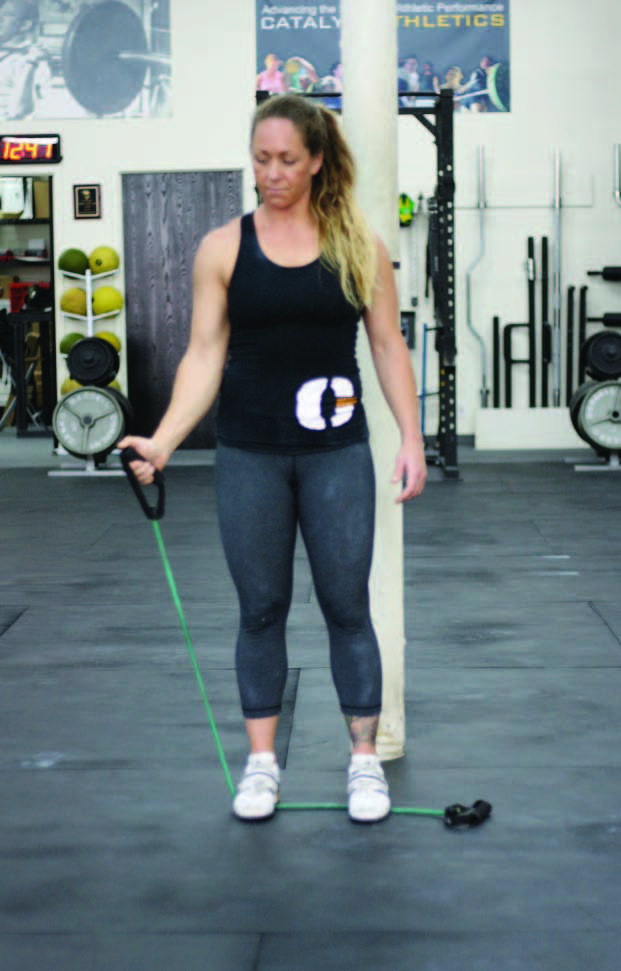
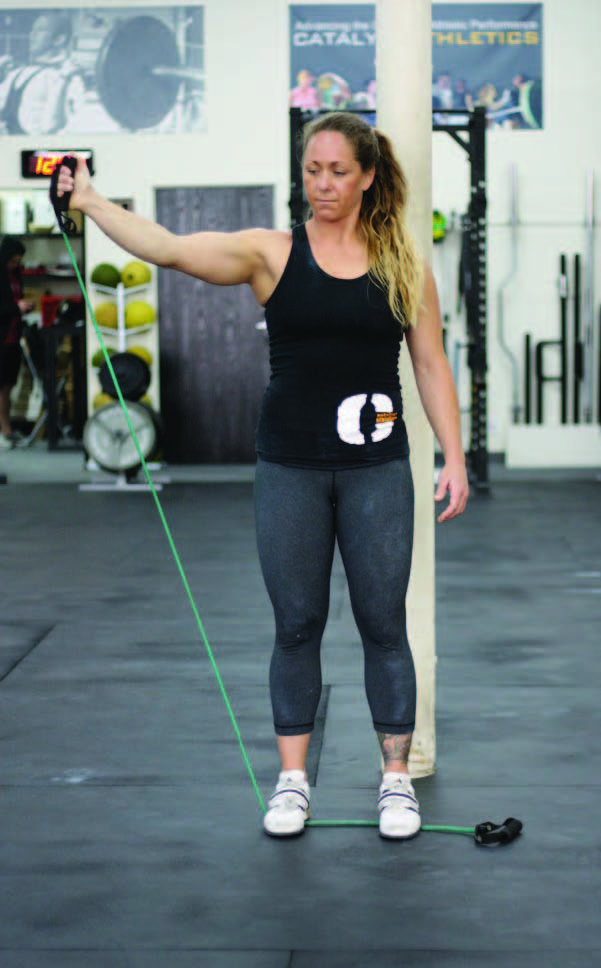
Abduction (with weight)
Perform the exercise the same as with the elastic making sure to maintain the up for one down for three pace. To help prevent shoulder injuries, this pace can be used when performing lateral flys as well--but a lower weight will likely be needed.
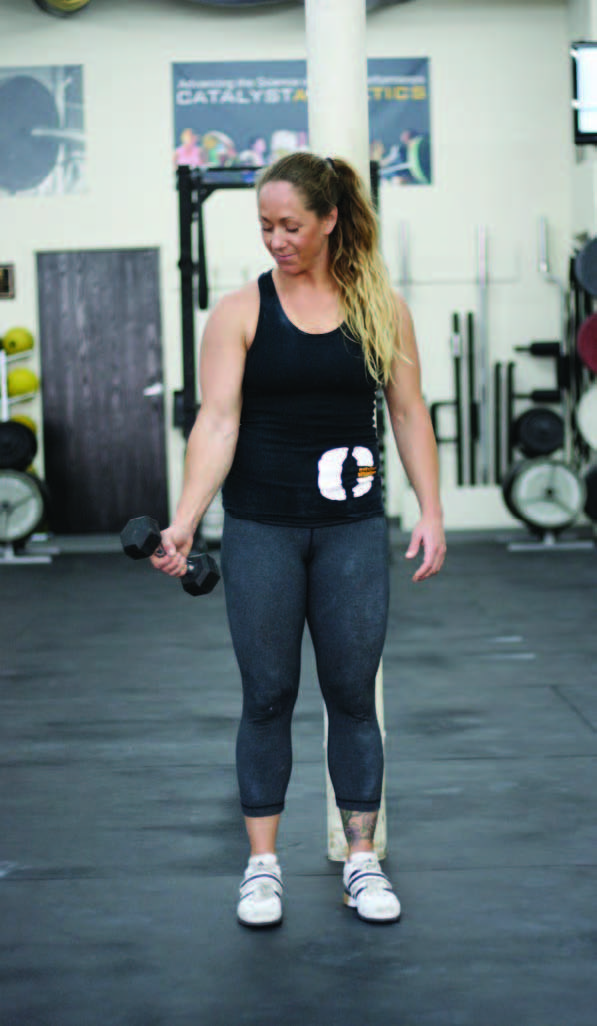
.jpg)
Scapular Stabilizers
The most important scapular stabilizers are the upper trapezius, lower trapezius, rhomboids, and serratus anterior. Let’s look at each of these muscles individually.
Upper Trapezius
Studies indicate that upper trapezius weakness is rarely the issue in shoulder injuries. In fact, the upper trapezius is usually shortened--especially in today’s world of sitting and hunching forward. It should be noted that when muscles are shortened and tight they are in fact weaker than if they were at a more ideal resting length. However, strengthening alone is unlikely to increase the strength since the muscle will still be shortened. For this reason, the upper trapezius should be stretched for shoulder injury prevention. To stretch this muscle, sit in a chair or on a bench and hold onto the seat with the hand of the arm you want to stretch. Lean away from that side with your body and your head while keeping your face pointed forward. Hold for 20 seconds and repeat on other side.
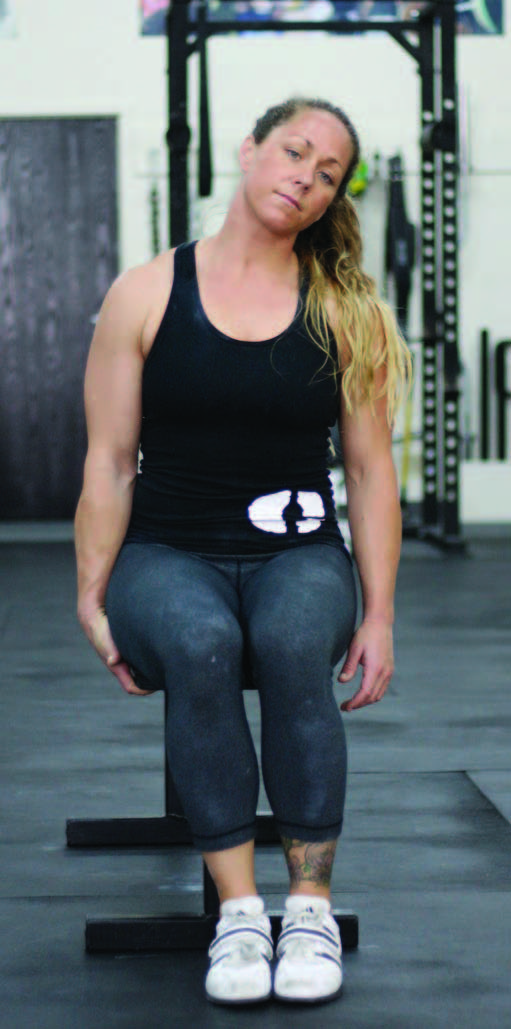
Lower Trapezius
To strengthen the lower trapezius, lay face down with your chest on an exercise ball so that you are almost parallel to the floor. Hold a 1-5 pound weight in each hand. Lift each arm alternately over your head. When lifting up the weights, be sure to keep your hands outside of the width of your shoulders to avoid impingement. Focus on keeping the bottom tip of the shoulder blade against the ribcage and remember to go up for a count of one and down for a count of three.
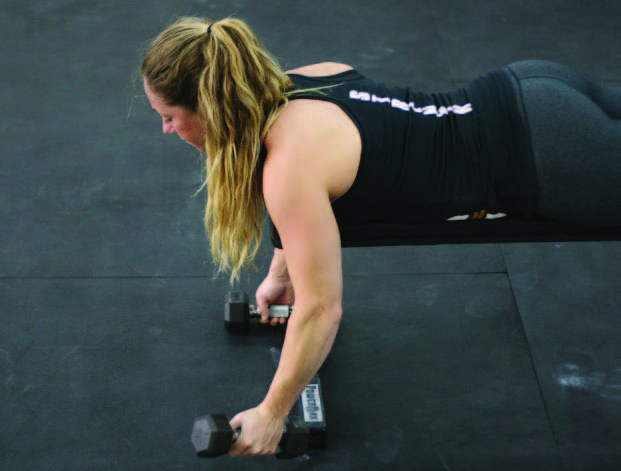
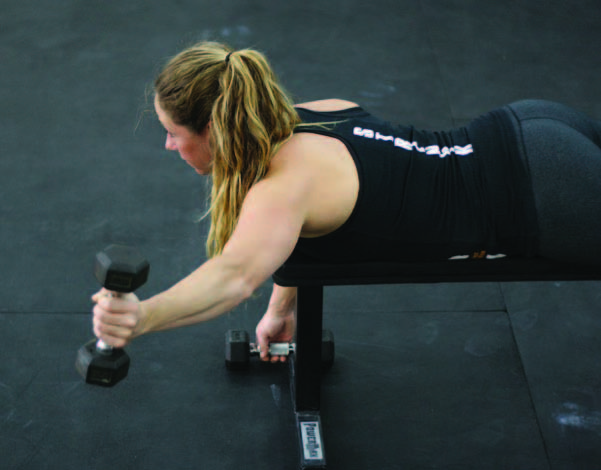
Rhomboids
The rhomboids are located between the shoulder blade and the spine and are responsible for pulling the shoulder blade inwards. The rhomboids can be strengthened by doing any type of row, as long as you focus on “pinching” the shoulder blades together.
Serratus Anterior
The serratus anterior is a muscle that is often overlooked and often weak. To evaluate for serratus anterior weakness, look for a phenomenon known as scapular winging. If the bottom or inside edge of your shoulder blade “wings out” or sits off of the rib cage, it is a good idea to strengthen the serratus anterior. This can be exaggerated by pushing against a wall, which would cause greater winging if the muscle is weak. To strengthen the serratus anterior, you can do what is called a push up plus. Simply get into a push up position with your elbows straight. Now instead of dropping down, push yourself up a little further by pulling your shoulder blades forward. This can also be done with a weight while laying on your back by simply holding the weight like you would for a bench press and pushing it further up. Again, focus on up for a count of one and slowly down for a count of three.
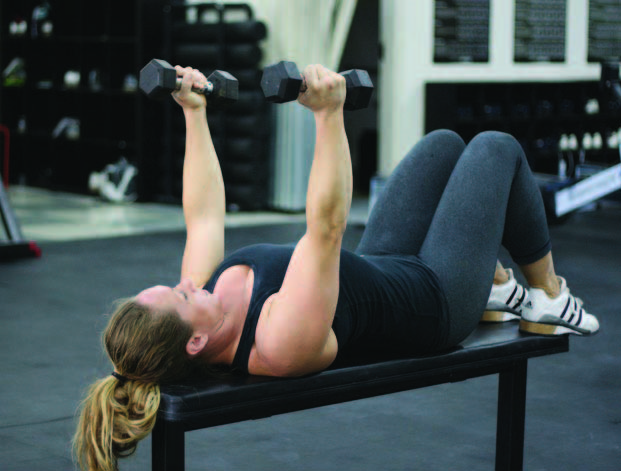
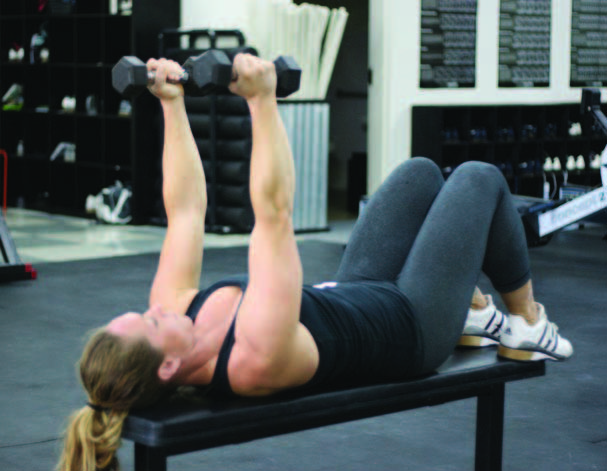
Other Exercises/Tips
Levator Scapulae
The levator scapulae is a muscle that extends from the upper inside corner of the shoulder blade to the upper vertebrae in your neck. This muscle is often tight and shortened in people that have the classic head forward, “sit at a computer all day” posture. The levator must relax and lengthen when the upper trap contracts to allow the shoulder blade to rotate as the arm lifts. Therefore, it is an important muscle to stretch to prevent conditions such as shoulder impingement. To stretch the levator sit in a chair and hold the seat with the side you would like to stretch, just as in the upper trap stretch discussed above. Lean away from the side to be stretched except this time turn your head towards the direction you are leaning. This will isolate the levator.
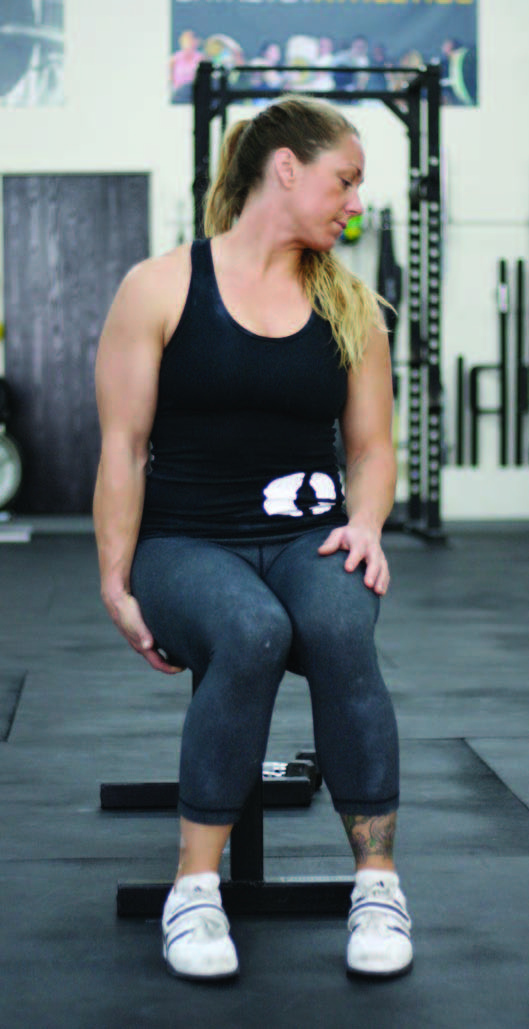
Proprioceptive Neuromuscular Facilitation (PNF)
PNF is basically a big term for exercises which train the joints of the body to know where they are in relation to other structures, and train the body to fire certain muscles at certain times to control movement and protect joints. Two of these exercises can be used in a very effective way to help protect the shoulder by combining many of the movements already discussed.
To perform the first exercise, attach an elastic band to an object at floor level and stand with the side you wish to exercise facing away from the elastic. With the elastic in hand, begin with hand at opposite hip with palm facing backward. The exercise itself is essentially removing a sword from a sheath and holding it over your head. Pull the elastic across the body and end with your hand over your head and your palm facing forward. Perform the exercise slowly and follow your hand with your eyes from beginning to end, turning your head (not just your eyes) as you go. Return the sword to the sheath and repeat.
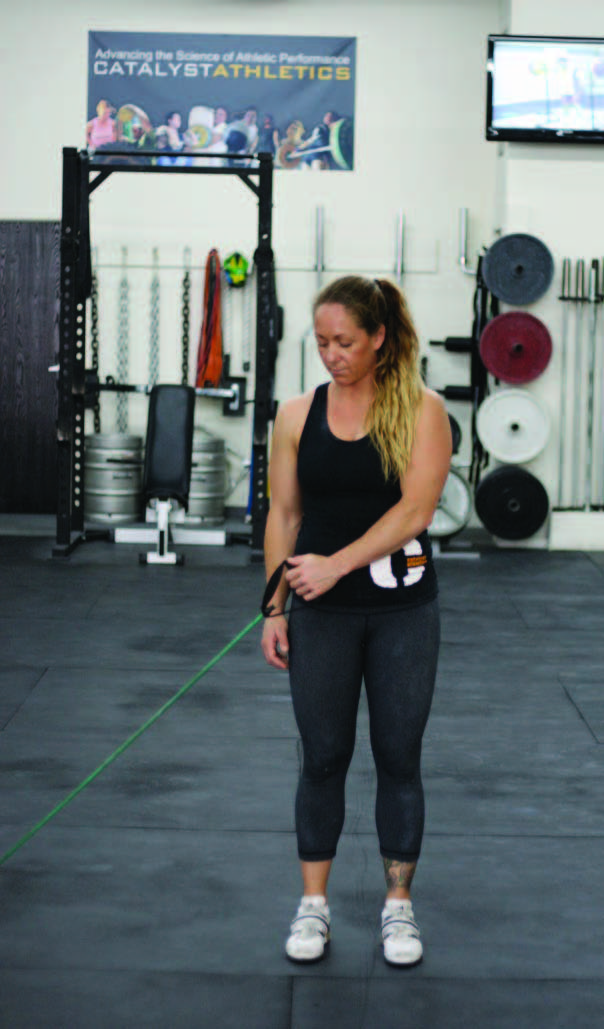
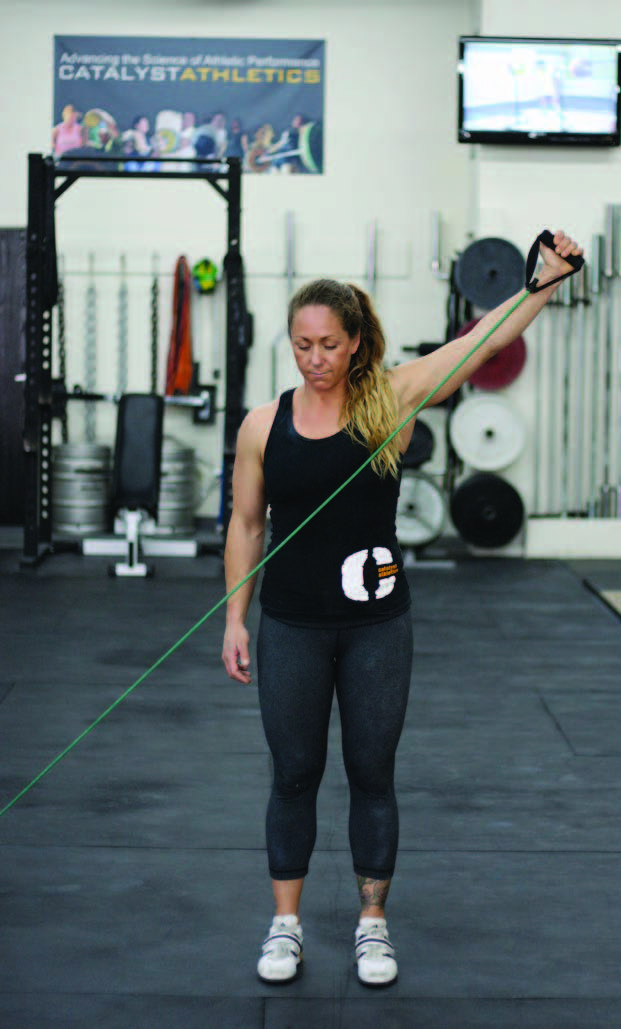
The second exercise is essentially the opposite. Begin with elastic attached to something above your head, with the side you wish to exercise facing the elastic. Begin with hand over the head and palm facing forward, and end with hand at opposite hip and palm facing backward. Remember to perform slowly and follow your hand with your eyes, just as before. When performing both of these exercises, try to avoid shrugging your shoulder. Also, focus on keeping your shoulder blade pressed against your rib cage as it moves.
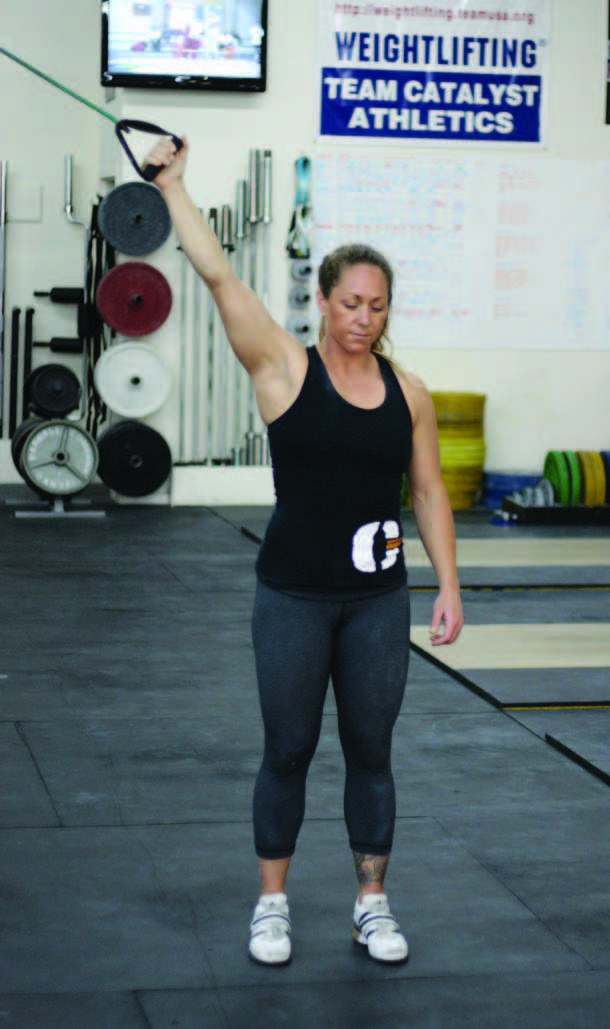
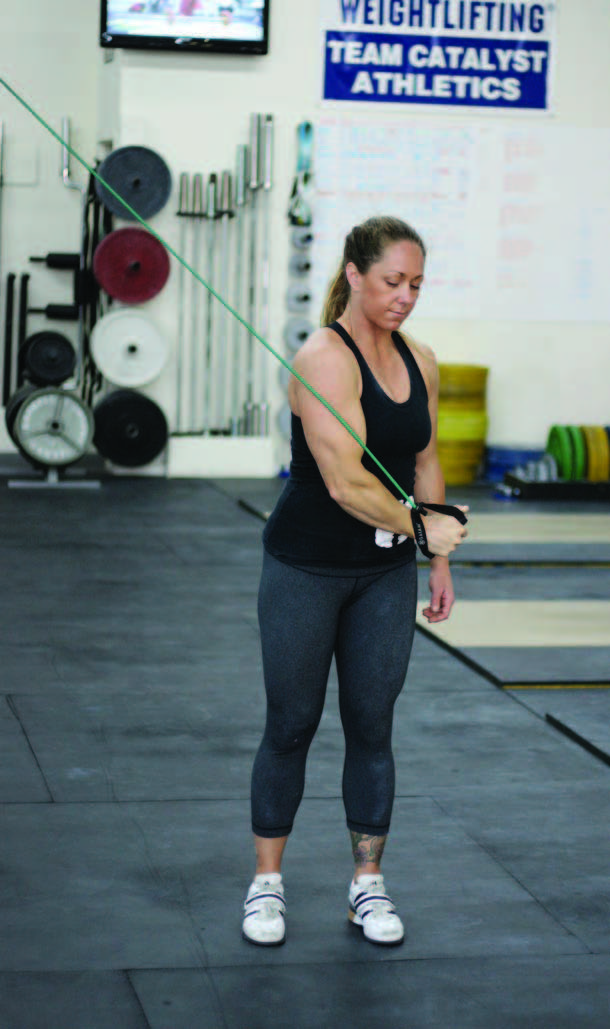
These exercises are so effective because they combine abduction, internal rotation, external rotation and scapular motion in two exercises. By performing them slowly in both directions, they also force all of the muscles involved to contract while lengthening. When you follow the hand by turning your head, you are training the muscles that connect the shoulder and neck to contract/relax in time with shoulder movement. By training the small stabilizer muscles in your shoulders, you can avoid shoulder injuries and get the most out of your weekend baseball tournament or your shoulder day at the gym.
Shoulder Mechanics
The shoulder is one of the most flexible and mobile joints in the human body. Most joints have significant freedom in one plane and minor freedom in other planes. Consider the knee or elbow, which can flex and extend but have much more limitation in rotation. The reason the shoulder and hip have greater freedom of movement is their ball and socket design. The shoulder’s ball, known as the humeral head, is only 33% covered by the socket, or glenoid cavity, which is a part of the shoulder blade. This is the reason the shoulder has more range of motion than the hip. Due to the lack of bony structure supporting the shoulder joint, it requires significant muscular support to maintain stability.
The shoulder is actually four separate joints which work together to form what is called the shoulder complex, this also contributes to the freedom that the human shoulder exhibits. The ball and socket part of the shoulder complex is known as the glenohumeral joint. Above the glenohumeral joint is the acromioclavicular (AC) joint, which forms between the shoulder blade and the collarbone. The collarbone forms a joint with the sternum near the center of the chest. The shoulder blade forms a pseudojoint with the ribcage and this is the fourth part of the shoulder complex. Since the shoulder blade is a part of three of the four joints, the stability, mobility and strength of the muscles surrounding the shoulder blade are extremely important in shoulder health.
Although the muscular support system of the shoulder is vital in stabilization, there is a passive system of support as well. The labrum, which is a soft fibrous tissue, extends out from the glenoid cavity to help support the humeral head. This essentially deepens the glenoid cavity, which gives the ball a deeper socket to rest in. Several ligaments support the shoulder complex and help to support both the AC joint and glenohumeral (ball and socket) joint. One of the most important non-muscular supports is the joint capsule. This is also one of the most overlooked structures in shoulder health. The capsule is a fibrous structure that surrounds the entire joint. Although these passive structures are important in supporting the shoulder they often don’t play a role until the end range of a given motion. For example, if you lift your arm out to the side, the inferior shoulder ligaments don’t tighten until the arm is above your head, at which point they stop the motion. This fact is important in incidents like falls and fast, aggressive movements. In a fall on an outstretched hand, muscles contract to slow your body down as you hit the ground. If the muscles are not strong enough or do not react quickly enough to slow the body’s momentum before the shoulder reaches the end of its range of motion, the force is then transferred to the labrum, capsule, and ligaments which are then vulnerable to injury. In a fast, aggressive motion such as pitching, this occurs during deceleration after the ball is released. The muscles, mostly the posterior muscles, have to slow the arm down to prevent the shoulder from being pulled out of socket by the forward momentum. If the muscles are too slow or too weak the force is transferred to the labrum and capsule. This is also true of a motion such as the snatch. As the weight comes to a stop at the top of the motion the shoulders are essentially at end range. If the muscles cannot stop enough of the momentum, the force is again transferred to the passive structures.
Shoulder position has a large impact on the stabilizing structures. A good example of this is shoulder abduction. Try to lift your arm straight out to the side with your thumb pointed down (internally rotated). The shoulder will stop at approximately 120 degrees. Now try the same motion with the thumb pointed up. A healthy shoulder will now be able reach well above your head. The rotation that takes place at the top of your shoulder causes different forces on the stabilizing structures. With the thumb pointed down the anterior portion of the shoulder capsule twists, which causes it to tighten earlier in the motion.
The Problem
The great mobility the shoulder complex allows is also the reason it is prone to injury. Perfect shoulder motion involves the humeral head remaining perfectly centered in the glenoid cavity. If the humeral head moves out of the center of the glenoid as the arm is moved, then more pressure is placed on the structures and tissues responsible for shoulder stability. Shoulder instability is considered to be a precipitating factor in many shoulder conditions including impingement, tendinitis, rotator cuff tears and osteoarthritis. Movement of the humeral head is called translation. For example, when a pitcher’s arm begins to accelerate forward, a large posterior force is exerted on the end of the arm. This causes the humeral head to want to move forward or translate anteriorly (similar to a lever). Studies have shown that one of the most important muscles at this phase is the latissimus dorsi, which fires to prevent this from happening. In weightlifting, one of the most common ways to injure a shoulder is to do a deep bench press where the elbows are behind the torso. The weight is a large backward force on the end of the arm. This can cause the humeral head to translate, or shift, forward. If you have ever been told to balance bench presses with bent over rows or other back exercises, now you know the reason why.
One of the most well-known and important stabilizers of the shoulder is the rotator cuff. The cuff is actually comprised of four muscles that originate on the shoulder blade and insert into the humerus. The reason the cuff is so important is that its main function is to keep the humeral head centered in the glenoid cavity, as was earlier discussed. The cuff accomplishes this in two main ways, compression and depression. The supraspinatus, which is above the ball and socket joint, pulls or compresses the humeral head into the glenoid cavity. The other three muscles work to pull the humeral head down and prevent it from translating upwards. These two mechanisms put a large emphasis on muscle balance. The shoulder stays healthy by having muscles with forces that pull in opposite directions work together to rotate the arm without causing translation (or shifting), this is called a force couple. Again, the best example of this is lifting the arm up straight out the side. As the arm is lifted up most of the power to actually lift the arm is provided by the deltoid (around 89%). This force also pulls the humeral head upwards. The rotator cuff steps in to compress the humeral head into the glenoid cavity and depress, or hold down, the humeral head. An imbalance of this force couple causes the humeral head to translate superiorly. If you have ever seen someone doing flys and shrugging their shoulders dramatically, they are using their trapezius muscles to pull the structures above the ball and socket joint out the way as their humeral head translates upward.
Another important force couple exists between the muscles that surround the shoulder blade. Since the glenoid cavity is part of the shoulder blade, it must rotate to move the glenoid with the humerus. Also, the acromion, which is the “A” in AC joint and attached to the shoulder blade, is located above the humerus. If the shoulder blade rotates so the glenoid can follow the humerus upward, the acromion moves with the glenoid and is no longer in the way. The glenoid cavity can also move forward and backward to some extent which helps prevent anterior and posterior translation of the humeral head. This involves the shoulder blade moving forward along the ribcage. The force couples that surround the shoulder blade involve the upper trapezius, lower trapezius, rhomboids, and serratus anterior muscles. Due to their different directions of pull, these muscles rotate and spin the scapula to keep up with arm movement. Think of our earlier example of the pitcher’s arm accelerating forward. As the elbow experiences a strong force in the backward direction and the humeral head is pushed forward, the glenoid cavity moves forward slightly to keep up. To further complicate this issue, the humerus is forcefully and dramatically externally rotated. If you have ever seen a still picture of a pitcher in mid-throw, you know what I am talking about. As the humeral head spins, the glenoid must spin as well. If you want to feel this happen lift your right arm to shoulder height with your elbow at a 90-degree angle. Put your left hand on the lowest most lateral part of the right shoulder blade. Now externally rotate your right arm by moving your right hand backwards while keeping your right elbow where it is. You should feel the tip of the shoulder blade move forward. This motion is the shoulder blade rotating so the glenoid can keep up with the humerus. The coupling of motion between the different moving parts of the shoulder complex is put to the test by the speed involved in throwing a baseball. While lifting weights is not done as quickly as throwing, the shoulder is stressed by a different force, the weights.
Pre-hab
To protect the shoulder joint, it is important to approach it from two ways: strength and flexibility. A fine balance has to exist between strength and flexibility for the shoulder to work correctly. The strength portion of shoulder injury prevention can then be further broken up into the rotator cuff and shoulder blade muscles. All exercises and stretches should be performed on both sides.
Rotator Cuff
To strengthen the rotator cuff, it is best to use an elastic cord or 1-4 pound weight depending on strength level. The rotator cuff can be strengthened using three exercises: internal rotation, external rotation and abduction. Research has shown that working muscles in an eccentric fashion is beneficial for rehabilitation and injury prevention. An eccentric contraction occurs when a muscle is contracting but increasing in length. This happens as the posterior shoulder muscles slow a pitcher’s arm down, the quadriceps slow/stop a squatter’s drop down, or a pectoralis slows/stops the weight bar during a bench press. These exercises can all be performed every other day or 3 times per week, 3 sets of 8-12 reps.
Internal Rotation (with elastic)
Internal rotation strengthens the subscapularis muscle, which is located on the back surface of your armpit. This muscle is the primary internal rotator of the humerus and is important for depressing the humeral head and also preventing the humeral head from translating forward. To perform the exercise, attach a rubber cord to an object at waist height. Stand with the side you wish to exercise facing the cord and grasp the cord in that hand. Stand far enough away that there is a mild tension in the cord. Keeping your elbow pressed against your side, bring your arm to your stomach and slowly return to starting position. Try to bring the arm to your stomach for a count of one and back to the beginning at a count of three. Avoid using your hips/core to rotate and focus on slowly rotating the humerus.


Internal Rotation (with weight)
Lie on the shoulder you want to exercise and roll slightly back so you are mostly laying on the shoulder blade. Start with a small weight in your hand resting on the floor. Bring the arm to your stomach. Focus on up for a count of one, down for a count of three.


External rotation (with elastic)
Perform this exercise the same as internal rotation, except with the arm you wish to exercise facing away from the attachment point of the elastic. Begin with the forearm against your midsection and rotate outward, keeping your elbow pressed against your side. Focus on going out for one second and back in for three seconds. This exercise will strengthen the teres minor and infraspinatus (rotator cuff muscles) and will help prevent the humeral head from impinging on structures above it.
.jpg)

External rotation (with weight)
Perform exercise the same as internal rotation except lie on the non-exercise side. Again focus on going up for one second and down for three seconds.


Abduction (with elastic)
Stand on an elastic band with your right foot to work the right shoulder and vice versa for the left. Start with arm at side and lift up with the arm straight. This exercise should be performed with the thumb pointing upward. To prevent aggravation of existing shoulder injuries, the arm should be lifted at an angle halfway between straight forward and straight to the side as this minimizes any impingement of the humeral head. Focus on going up for a count of one second, down for a count of three.


Abduction (with weight)
Perform the exercise the same as with the elastic making sure to maintain the up for one down for three pace. To help prevent shoulder injuries, this pace can be used when performing lateral flys as well--but a lower weight will likely be needed.

.jpg)
Scapular Stabilizers
The most important scapular stabilizers are the upper trapezius, lower trapezius, rhomboids, and serratus anterior. Let’s look at each of these muscles individually.
Upper Trapezius
Studies indicate that upper trapezius weakness is rarely the issue in shoulder injuries. In fact, the upper trapezius is usually shortened--especially in today’s world of sitting and hunching forward. It should be noted that when muscles are shortened and tight they are in fact weaker than if they were at a more ideal resting length. However, strengthening alone is unlikely to increase the strength since the muscle will still be shortened. For this reason, the upper trapezius should be stretched for shoulder injury prevention. To stretch this muscle, sit in a chair or on a bench and hold onto the seat with the hand of the arm you want to stretch. Lean away from that side with your body and your head while keeping your face pointed forward. Hold for 20 seconds and repeat on other side.

Lower Trapezius
To strengthen the lower trapezius, lay face down with your chest on an exercise ball so that you are almost parallel to the floor. Hold a 1-5 pound weight in each hand. Lift each arm alternately over your head. When lifting up the weights, be sure to keep your hands outside of the width of your shoulders to avoid impingement. Focus on keeping the bottom tip of the shoulder blade against the ribcage and remember to go up for a count of one and down for a count of three.


Rhomboids
The rhomboids are located between the shoulder blade and the spine and are responsible for pulling the shoulder blade inwards. The rhomboids can be strengthened by doing any type of row, as long as you focus on “pinching” the shoulder blades together.
Serratus Anterior
The serratus anterior is a muscle that is often overlooked and often weak. To evaluate for serratus anterior weakness, look for a phenomenon known as scapular winging. If the bottom or inside edge of your shoulder blade “wings out” or sits off of the rib cage, it is a good idea to strengthen the serratus anterior. This can be exaggerated by pushing against a wall, which would cause greater winging if the muscle is weak. To strengthen the serratus anterior, you can do what is called a push up plus. Simply get into a push up position with your elbows straight. Now instead of dropping down, push yourself up a little further by pulling your shoulder blades forward. This can also be done with a weight while laying on your back by simply holding the weight like you would for a bench press and pushing it further up. Again, focus on up for a count of one and slowly down for a count of three.


Other Exercises/Tips
Levator Scapulae
The levator scapulae is a muscle that extends from the upper inside corner of the shoulder blade to the upper vertebrae in your neck. This muscle is often tight and shortened in people that have the classic head forward, “sit at a computer all day” posture. The levator must relax and lengthen when the upper trap contracts to allow the shoulder blade to rotate as the arm lifts. Therefore, it is an important muscle to stretch to prevent conditions such as shoulder impingement. To stretch the levator sit in a chair and hold the seat with the side you would like to stretch, just as in the upper trap stretch discussed above. Lean away from the side to be stretched except this time turn your head towards the direction you are leaning. This will isolate the levator.

Proprioceptive Neuromuscular Facilitation (PNF)
PNF is basically a big term for exercises which train the joints of the body to know where they are in relation to other structures, and train the body to fire certain muscles at certain times to control movement and protect joints. Two of these exercises can be used in a very effective way to help protect the shoulder by combining many of the movements already discussed.
To perform the first exercise, attach an elastic band to an object at floor level and stand with the side you wish to exercise facing away from the elastic. With the elastic in hand, begin with hand at opposite hip with palm facing backward. The exercise itself is essentially removing a sword from a sheath and holding it over your head. Pull the elastic across the body and end with your hand over your head and your palm facing forward. Perform the exercise slowly and follow your hand with your eyes from beginning to end, turning your head (not just your eyes) as you go. Return the sword to the sheath and repeat.


The second exercise is essentially the opposite. Begin with elastic attached to something above your head, with the side you wish to exercise facing the elastic. Begin with hand over the head and palm facing forward, and end with hand at opposite hip and palm facing backward. Remember to perform slowly and follow your hand with your eyes, just as before. When performing both of these exercises, try to avoid shrugging your shoulder. Also, focus on keeping your shoulder blade pressed against your rib cage as it moves.


These exercises are so effective because they combine abduction, internal rotation, external rotation and scapular motion in two exercises. By performing them slowly in both directions, they also force all of the muscles involved to contract while lengthening. When you follow the hand by turning your head, you are training the muscles that connect the shoulder and neck to contract/relax in time with shoulder movement. By training the small stabilizer muscles in your shoulders, you can avoid shoulder injuries and get the most out of your weekend baseball tournament or your shoulder day at the gym.
|
Dr. Nolan Mitchell is a chiropractic physician at St. Croix Spinal Care and Sports Rehabilitation Center with a focus on soft tissue therapies, athletic injuries and physical rehabilitation. He is a graduate of Northwestern Health Sciences University and will be completing certification as a chiropractic sports physician in the fall of 2011. He has received advanced training in soft tissue therapies, including Graston Technique. He is passionate about youth sports and was a pitcher in college. |
Search Articles
Article Categories
Sort by Author
Sort by Issue & Date
Article Categories
Sort by Author
Sort by Issue & Date

